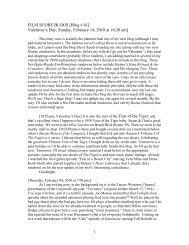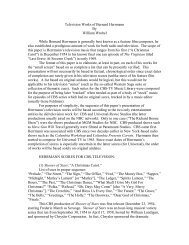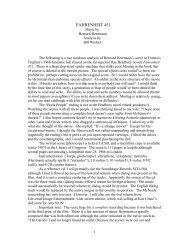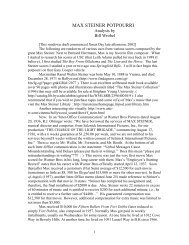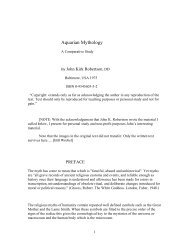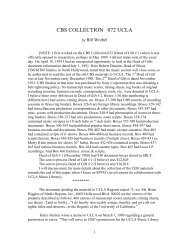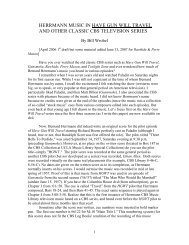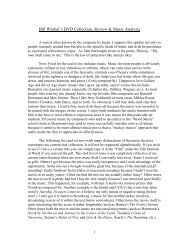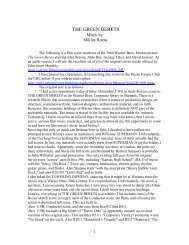TEMPO MARKINGS OF BERNARD HERRMANN SCORES ...
TEMPO MARKINGS OF BERNARD HERRMANN SCORES ...
TEMPO MARKINGS OF BERNARD HERRMANN SCORES ...
You also want an ePaper? Increase the reach of your titles
YUMPU automatically turns print PDFs into web optimized ePapers that Google loves.
slow) or simply moderately show (a moderate walking tempo). Allegretto is considered<br />
moderately fast, whereas Allegro is fast (and rather cheerful and lively), rather quick.<br />
Moderato is of course “moderate” (a highly generalized and relative indication).<br />
Similarly Lento is “slow” but not as slow as Largo (very slow and broad) and perhaps<br />
even Grave (slow, seriously solemn & heavy). Presto is faster than Allegro, very fast or<br />
quick in fact (almost virtuosic). Vivace is normally lively, spirited & bright, but not<br />
necessarily very fast, while others feel it is indeed quick and lively. Vivo, however, tends<br />
to be judged as meaning quick & lively (although Allegro vivace) would more accurately<br />
indicate this since Allegro is the major tempo indicator with vivace being its modifier).<br />
Moreover, many times Vivo is considered to be simply a synonym of Vivace (both<br />
predominantly used as modifiers, although Herrmann used vivace more as the modifier<br />
and Vivo often as a main tempo marking (for example, Vivo for “The Chariot Ride” cue<br />
in The Egyptian). Vivace tends to incorporate both a mood association and a tempo<br />
association. It is “lively” so the term tends to mean a rather fast, animated movement.<br />
Maestoso is another dual-nuanced marking. It tends to mean majestic or stately and hence<br />
mean a relatively slow, solemn movement.<br />
So qualifiers such as Vivace are mood markers that seem to add character<br />
connotations in addition to metronome marking suggestions. They are both descriptive<br />
terms and metronome setting associations. Qualifiers to primary tempo markings are<br />
quite helpful for the composer to convey the intended mood of the piece or section of a<br />
piece, or to adjust the ever-changing mood of music in a long piece. It helps the player<br />
perform according to a certain style of playing or according to a suggested “feeling.”<br />
Modifiers such as accell. and rall. are simple indicators instructing the performers to<br />
gradually increase the speed (accell.) or gradually reduce the speed (rall. or ritard.) of a<br />
section of music (normal fluctuations in the tempo of music).<br />
Now: Tempo is Italian for “time” (literally speaking). Italian became the default<br />
universal musical language for terms for conveying relative speed, mood indicators, and<br />
other dynamics since the end of the 17 th century. I believe Frescobaldi’s “adagio” became<br />
the first established indication (officially?) for the beginning of tempo markings, although<br />
Beethoven is normally associated for its consistent use (by a famous composer). Tempi<br />
range from the very slow (such as Largo) to the very fast (such as Prestissimo). Moderato<br />
became the standard midpoint or temperate speed (neither too slow or too fast). Call it the<br />
middle slice of the musical tempo pie. Normally the pace or speed of music is broken<br />
down into regular intervals of time called beats. The number of beats in a given period<br />
are calculated. The accepted standard measurement period is one minute, hence b.p.m.<br />
(beats per minute). Ideally the beginning of a piece should indicate both the metronome<br />
marking (or equivalent) and the tempo marking--Italian or English or whatever language<br />
the composer holds but it’s best to keep it in Italian for “serious” music (as opposed to,<br />
say, modern “pop” music).<br />
Remember that there is no direct equivalence between the two. Allegro does not<br />
necessarily mean 120 b.p.m., and 60 b.p.m. does not necessarily mean Lento. It’s all<br />
relative, meant as a guide. Also realize that 60 b.p.m. can be written out as 120 b.p.m. if<br />
you alter the notational style or structure of your particular piece. So if you double the<br />
notation to convert 60 to 120 b.p.m., then you have to make, say, a quarter note into a<br />
half note, a half note into a whole note, and so forth. You will create more bar lines in<br />
your work (!) but it would not affect the music’s real life speed. Ideally, however, the<br />
3




